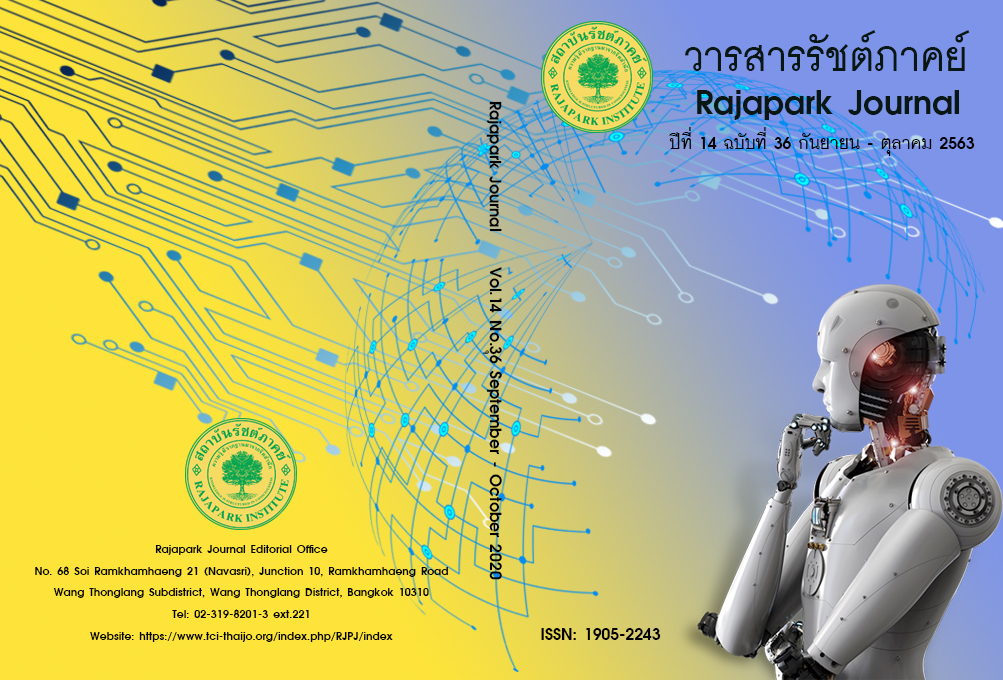Legal Measures on Air Pollution from Large Industrial Plants in Thailand that Generate Small Dust Particles PM 2.5
Main Article Content
Abstract
This research aims to explore the air pollution situation in Thailand, concepts, theories as well as laws relevant to air pollution, compared to foreign laws. Another purpose is to study legal problems to propose solutions and legal measures that can be enforced appropriately. This research was conducted by means of qualitative research through examination of documents, the study of legislative provisions, thesis, related research from websites to collect data, which was studied, analyzed, and arranged systematically. According to the study, air pollution caused by the industrial factory in Thailand is released from fuel combustion or industrial production processes. For the control of air pollution caused by industrial factory acts on primary law that regulates and controls air pollution is The National Environmental Quality Act, B.E. 2535 (1992) and Factory Act B.E. 2535 (1992). It is required to issue main measures to control and punish, and determine additional measures to motivate production processes Therefore, legal measures suitable for controlling air pollution from the industrial factory as follows: 1) Additional administrative measures to suspend licenses. 2) Standard configurations for dust removal that fixes a diameter of fewer than 2.5 microns (PM 2.5) 3) Establishing incentive measures to improve the production process. 4) Setting rules for the establishment of an industrial factory, considering the distance between factories, and the required EIA there should be studied of air pollution from nearby factories. 5) Additional criminal penalties.
Article Details
Views and opinions appearing in the Journal it is the responsibility of the author of the article, and does not constitute the view and responsibility of the editorial team.
References
Boonsobhak, P., Boonsobhak, P., & Nathakitphaisal, N. (2018). Legal Measures to Prevent and Control Air Pollution Emitted fromIndustrial Factories. Kasem Bundit Journal, 19(Special Edition), 118-129.
Chiraweera, W. (2002). Law Enforcement on Air Pollution Caused by Vechicles: Case Study of Air Pollution in Bangkok Metropolitan. A Thesis for Degree of Master of Arts (Political Science), Ramkhamhaeng University.
Department of Industrial Works. (2019). PM 2.5 and Industry. Retrieved May, 15, 2020, from https://www.diw.go.th/hawk/job/%E0%B8%9A%E0%B8%97%E0%B8%84%E0%B8%A7%E0% B8%B2%E0%B8%A1%20PM2.5.pdf
Pochanart, P. (2016). The Present State of Urban Air Pollution Problems in Thailand’s Large Cities: cases of Bangkok, Chiang Mai, and Rayong. Journal of Environmental Management, 12(1) 114-133.
THAI JUNIOR ENCYCLOPEDIA PROJECT By Royal Command of H.M. the King. (1996). Volume 21, Story 8: Conservation and development of natural resources, problems of natural resources and environment. Retrieved May 5, 2020, from http://saranukromthai.or.th /sub/book/book.php?book=21&chap=8&page=t21-8-infodetail03.html
Thephasadin Na Ayuthaya, M. (2010). Determination of punitive damages in the environmental cases. A Thesis for Degree of Master of Laws, Thammasat University.
The Secretariat of the House of Representatives. (2015). Academic Focus, Air Pollution: Thailand's Environmental Management. Retrieved October, 20, 2019, from https://library2.parliament.go.th/ejournal/content_af/2558/may2558-2.pdf


